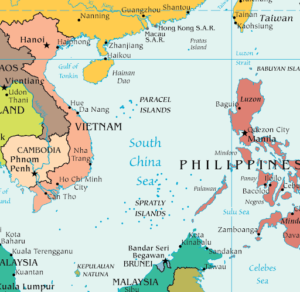In news– Code of Conduct for the South China Sea is now being discussed at the ASEAN Defence Ministers Plus meeting in Cambodia.
What is Code of Conduct for the South China Sea ?
- The Code of Conduct (COC) is intended to reduce the risk of conflict in the South China Sea in the disputed waterway where China’s expansive maritime and territorial claims clash with those of four ASEAN member states: Vietnam, Malaysia, the Philippines, and Brunei.
- The COC has been a perennial agenda item for China and ASEAN since the turn of the century, but its realization remains far off.
- The evolution of the CoC dates back to 1992, when ASEAN issued its first statement on territorial disputes in the South China Sea.
- Endorsing the concept of a CoC in 1996, they then signed a Declaration on the Conduct of Parties in the South China Sea (DoC) in 2002, with draft guidelines being adopted in 2011.
- While the DoC has already played a significant role in stabilising the area, a CoC would be an upgraded version that would take yet another step towards regional peace and stability.
About South China Sea-
- It is a marginal sea that is part of the Pacific Ocean, encompassing an area from the Karimata and Malacca straits to the Strait of Taiwan of around 3,500,000 square kilometres
- The South China Sea carries tremendous strategic importance;one-third of the world’s shipping passes through it.
- It contains lucrative fisheries, which are crucial for the food security of millions in Southeast Asia. Huge oil and gas reserves are believed to lie beneath its seabed
- States and territories with borders on the sea (clockwise from north) include: the People’s Republic of China, the Republic of China (Taiwan), the Philippines, Malaysia, Brunei, Indonesia, Singapore, and Vietnam.
- Major rivers that flow into the South China Sea include the Pearl, Min, Jiulong, Red, Mekong, Rajang, Pahang, Agno, Pampanga, and Pasig Rivers.

About ASEAN-
- The Association of South-East Asian Nations (ASEAN) is a political and economic union of 10 member states in Southeast Asia, which promotes intergovernmental cooperation and facilitates economic, political, security, military, educational, and sociocultural integration between its members and countries in Asia-Pacific.
- ASEAN’s primary objective is to accelerate economic growth and through that social progress and cultural development.
- A secondary objective is to promote regional peace and stability based on the rule of law and the principle of United Nations charter.
- ASEAN was preceded by an organisation formed on 31 July 1961 called the Association of Southeast Asia (ASA), a group consisting of Thailand, the Philippines, and the Federation of Malaya.
- ASEAN itself was created on 8 August 1967, when the foreign ministers of five countries- Indonesia, Malaysia, the Philippines, Singapore, and Thailand, signed the ASEAN Declaration.
- Today it comprises Indonesia, Singapore, Philippines, Malaysia, Brunei, Thailand, Cambodia, Lao PDR, Myanmar and Vietnam.
- It is headquartered in Jakarta, Indonesia.
















